Then and Now: Poland’s Tragic WWII History
The photo above is one of my favorite photos from WWII. Warsaw was completely destroyed by Germany at the end of the war, and the photo is of the statue of Christ Bearing His Cross laying in the middle of Warsaw’s rubble. Something about this photo always got to me. The way the statue is positioned seems to show hope and comfort in a time of pure suffering and despair. As if the statue is somehow saying, “It’s over now, we can rise from this.” This is why the first thing we did today on our tour of Warsaw’s WWII sites was find this statue. It is located near its original location, outside of the Church of the Holy Cross, and it was very moving to finally see this statue in person.
Poland and WWII
We spent our last day in Warsaw doing a self-guided tour of the WWII history in the city. Poland’s WWII history is one of the most interesting of all the countries that participated in the war. The invasion of Poland was unique in that initially, the two invading armies (Germany and the Soviet Union) were actually working together for the first two years of the war. Not only did the Germans and Soviets agree in private to simultaneously invade Poland, but they even held some joint victory parades across their newly gained territories. To the right is a photo of Soviet soldiers saluting a Nazi flag. Not something many people realize happened in WWII. After the war, the the Soviets were able to paint themselves to the world as a victim of German aggression, even though they helped start the terror and murder in Poland six years earlier.
Poland was a thriving country in early 1939, with a population of over 35 million people, including a Jewish population of over 3.2 million. Warsaw alone had the second highest Jewish population in the world, second only to New York City. By the end of the war, Poland was in ruins with a population down to under 24 million. Six of the eleven million lost from the country’s population were due to deaths at the hands of Germany and the Soviet Union, while the other five million drop was due to emigration to other countries as well as loss of territory gained prior to WWII (i.e. Lithuania). Of all the countries involved in WWII, Poland lost the highest percentage of its population. On average, 2,800 Polish citizens died per day during its occupation.
To give you an even better picture, we can look at just at the city of Warsaw where Alissa and I currently are. In 1939, the population of Warsaw was about 1.3 million. By 1945, at the end of the war, there was about 1,000 people left living in the ruins of the city. It makes it so much more amazing to see the city thriving today knowing what it went through 70 years ago.
WWII’s first victim and the invasion of Poland
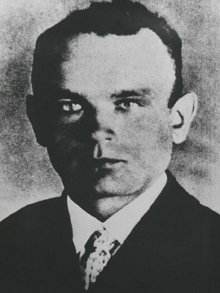
Franz Honiok, WWII’s first European victim.
WWII in Europe is considered to have started on September 1st, 1939, however, the first death actually occurred on the night of August 31, 1939. You’ve probably never heard of Franz Honiok, but he was a 43-year-old farmer who lived on the border of Germany and Poland, AND he was WWII’s first victim.
Hitler wanted to invade Poland to get the war started, but he needed some sort of reason to give the rest of the world for his invasion. There had been disagreements about the border area in the past, including violence and murder of both Germans and Poles living around the borders, but Poland’s never gave any sort of indication it had plans to use any sort of military force against Germany. So Hitler decided to fake some Polish aggression instead. He had a team of German SS members dress in Polish uniforms, break into a German radio station near the border of Poland, and broadcast a message saying “Poland is invading Germany and this station is in Polish hands.” They then took Franz Honiok, who was also dressed in a Polish uniform, drugged him unconscious, then shot him in the head to look like he had been killed by a German defending the station. They laid his body outside the station, forced the police to take photos, then sent the images to news outlets around the world to act as the proof of Polish aggression. The next day, Hitler invaded Poland, while the German media, the BBC, the New York Times, and other outlets around the world all picked up the story of the so-called Polish raid on a German radio station.
What followed during the next six years was an attempt to completely destroy a country and the people who lived there. By the way, the radio station is still there and can be visited, although we didn’t have enough time to make it there:
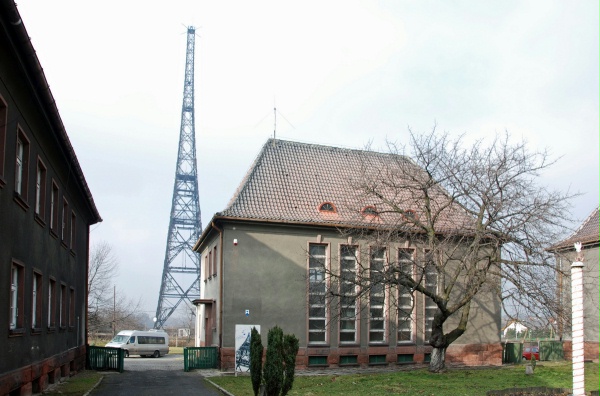
The Gleiwitz radio station today.
The Warsaw Ghetto: Then and Now
Throughout Europe, Germany created ghettos within occupied cities which they forced Jews to live in. Warsaw, because of its large Jewish population, was the home of the largest of these ghettos. The Warsaw Ghetto was created in 1940 when the Germans built walls to enclose a small area of the city and forced 400,000 people into it. At the time, 400,000 people was 30% of Warsaw’s population, yet they were forced to live in only 2.4% of all the area in Warsaw.
In a couple of months, Warsaw will be debuting a brand-new museum dedicated to both the victims of the Warsaw Ghetto as well as the Warsaw Ghetto Uprising. Since we are not yet able to visit a museum about the ghetto, Alissa and I decided to spend a few hours walking around the old ghetto area and seeing what it looks like now vs. in 1940. Side note: We visited the Holocaust Museum in Jerusalem (Yad Vashem) a few weeks ago and they have an entire room dedicated to the Warsaw Ghetto, including a recreation of the street. Visiting that museum before coming to Warsaw added so much understanding and perspective to this visit.
One of the most recognizable images of the Warsaw Ghetto is a footbridge that was built to connect the two parts of the ghetto. One of Warsaw’s busiest streets, Chłodna, ran directly through the ghetto. The Germans didn’t want to block off that street, so instead they split the ghetto in two and created the bridge in the photo below. There are many photos and videos of victims walking across this bridge, and it has become a symbol of the suffering and starvation within the ghetto. Alissa and I went to see what was left of this bridge area today. The bridge was torn down along with the rest of the ghetto after the uprising and liquidation in 1943. Today, there are two metal poles on each side of the street, connected by wires to symbolize where the bridge once stood. We were here during the day, but I have heard from others that they light the wires up at night. The street below the bridge is still original and the sidewalks are marked with the former location of the walls (see photo above). Below is a before and after shot of the bridge, and you can see there is still an original building left from those days as well.
Quick note about the new museum. We did go inside and see their temporary exhibit and the building is really incredible. If you are visiting Warsaw in the near future, be sure to look up whether or not the main exhibit is open or not. The official name of the new museum is Museum of the History of the Polish Jews, and it is not to be confused with the Warsaw Uprising Museum that I mention below which is also a must-see.
The Warsaw Uprising Museum
Our next stop of the day was to the Warsaw Uprising Museum. This museum is dedicated to the Poles who decided to fight back against German occupation with underground movements throughout the war as well as the actual uprising in August 1944. I’ve been to over 20 WWII museums, and I would rank the Warsaw Uprising Museum as one of the best. I could have spent 12 hours in this museum and still not see everything. The videos that have been installed throughout the exhibit are top notch and the relics throughout the museum are laid out perfectly.
The museum only seemed to get better the deeper we got into it. Here are what I consider to be the highlights of this museum and why it should be must-see for anyone coming to Warsaw:
- There is a 3D movie that was created that depicts a plane flying over the 1945 ruins of Warsaw. It is an incredible video and it really gives you a good perspective on what a city looks like after 85% of its buildings have been destroyed.
- During the Warsaw Uprising, two filmmakers shot over six hours of footage. The footage was edited quickly and was shown for free to citizens and soldiers in Warsaw during the uprising to inspire and encourage them. There is a large, movie theater sized screen that shows the newsreel in their original edited form, just as those Poles would have seen in 1945. Side note: The museum is finishing a full restoration of the footage and will be premiering an 85-minute color version of the film this month.
- There is a replica B-24 Liberator plane hanging in the museum’s main hall. Really cool to see, especially for anyone who has read Unbroken, the story of Louis Zamperini.
- The basement of the museum has been converted into a replica of the Warsaw sewers, which in 1945 were used as a headquarters by the Home Army during the uprising.
Below is the before and after photo I took for my First Impressions of Poland article that shows just how well Warsaw has been rebuilt:
Tomorrow we are heading to Krakow to visit Auschwitz and Birkenau. Be sure to check back for those reports.

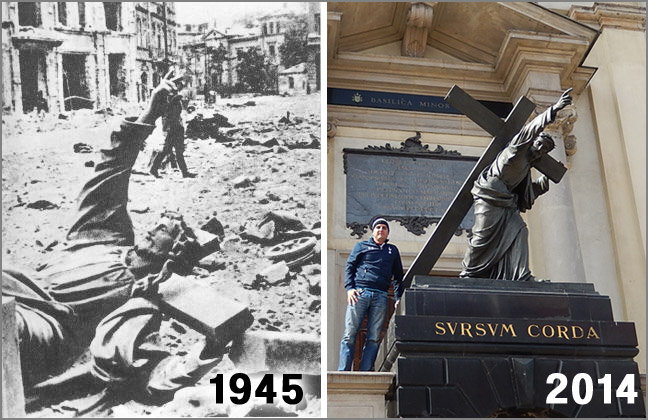
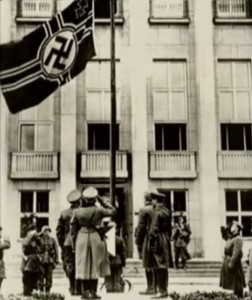
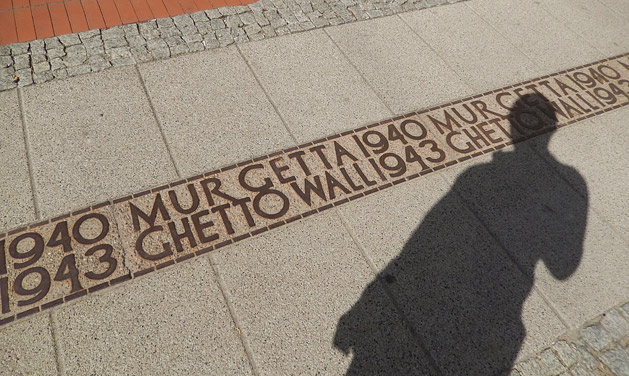
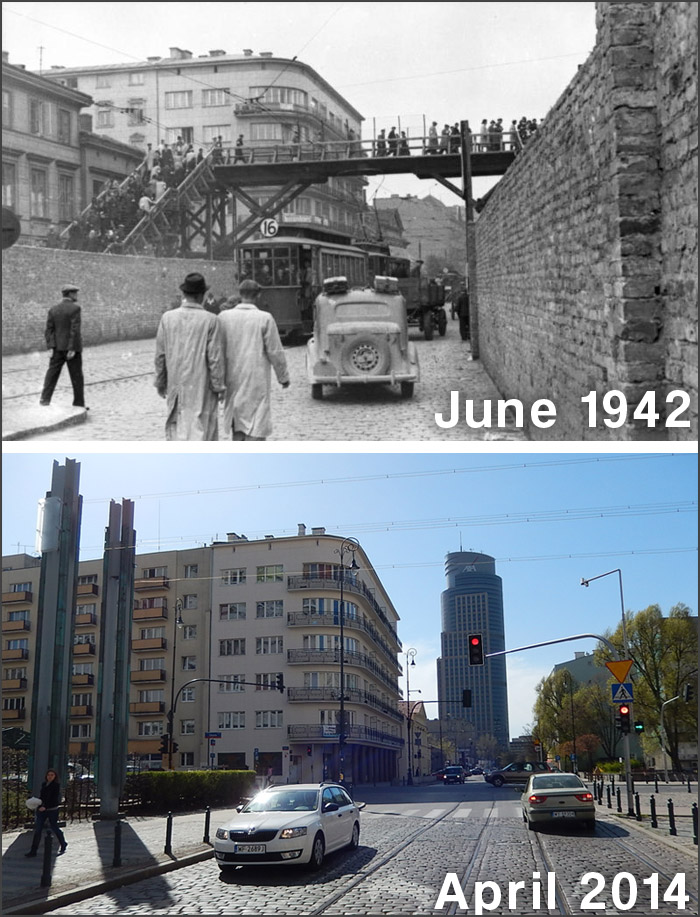
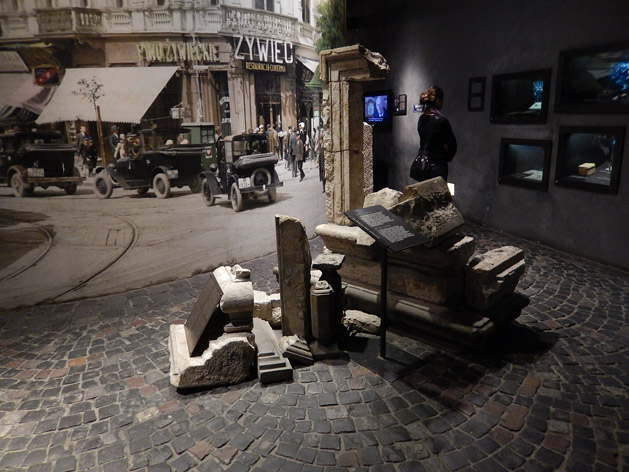
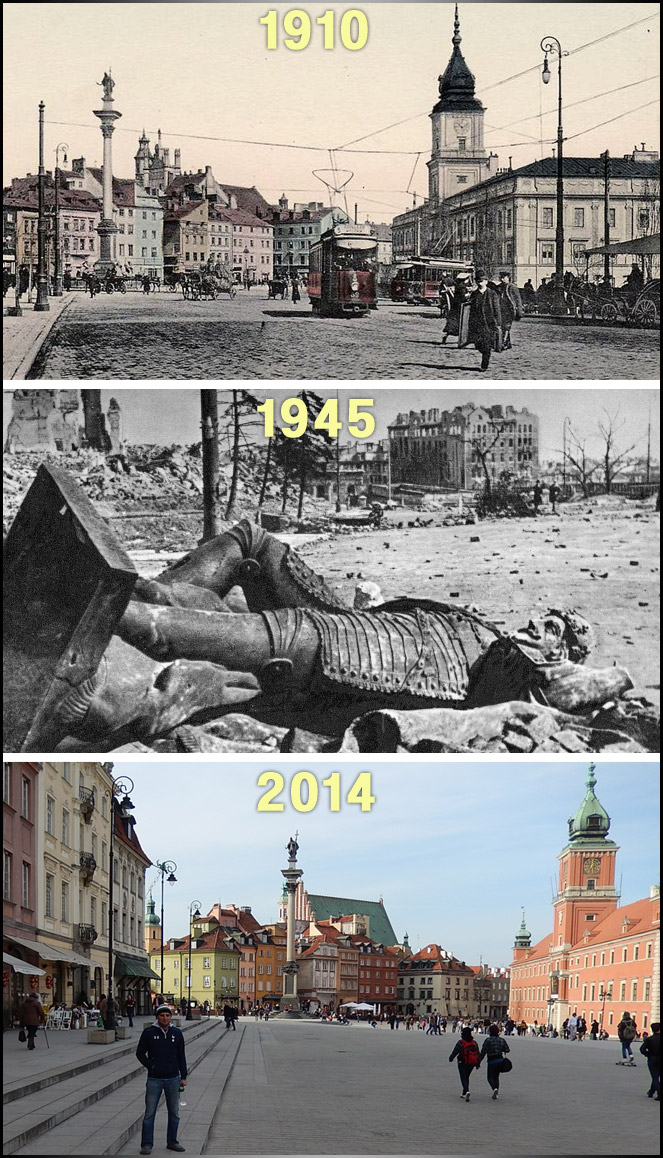



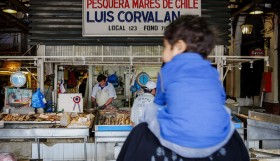















One Response to Then and Now: Poland’s Tragic WWII History